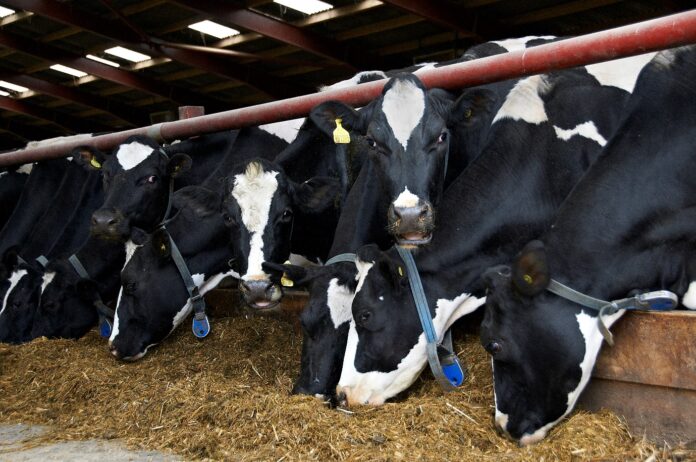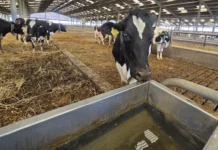
Feed efficiency, fertility improvements and milk production contribute to a +40 percent return on investment when feeding rumen-protected fats with milk at 40ppl
At a milk spot price of 40ppl, UK dairy farmers can see a return on investment of 40 percent when feeding high-C16:0 feed fat supplements on manufacturing milk contracts and a return on investment of 42 percent when feeding calcium salt feed fat supplements on liquid contracts.
These figures come from a performance-to-financial correlation model developed by Volac Wilmar Feed Ingredients that weighs current feed prices and milk contracts against recent research data on cow performance when feeding rumen-protected fat supplements in either calcium salt or high-C16:0 form.
“The continuous rise in feed commodity prices have many UK dairy farmers evaluating their rations for cost saving cutbacks. When looking down the feed budget sheet, feed fat supplements are going to be one of the big sticker items,” says Paul Fransen, the model developer and Business Development Manager for Volac Wilmar Feed Ingredients. “Research shows that fat and specific fatty acids influence multiple areas of cow production influencing profitability, so any changes to the ration needs to be calculated carefully and cautiously to prevent costly production or fertility consequences.”
The influence of fat and fatty acids on cow performance

The return on investment when feeding rumen-protected fat supplements is multifactorial as a result of the various areas of cow performance the nutrient influences, says Dr Richard Kirkland, ruminant nutritionist and Global Technical Manager for Volac Wilmar Feed Ingredients.
As a macronutrient, fat is energy dense with 500g of a fat supplement like Megalac increasing energy density by 0.5 MJ/kg DM. It is also a ‘safe’ ingredient in the rumen as it isn’t fermented like cereals so supplies energy without increasing risk of acidosis. In rumen-protected form, fat doesn’t interfere with fibre digestion which otherwise reduces feed efficiency and can lead to milk fat depression.
“Energy density benefits are seen particularly in early lactation rations as milk yield increases rapidly post-calving while dry matter and energy intakes rise at a slower rate. This leads to an ‘energy gap’ in early lactation when cows mobilise body fat and lose condition to supply the energy shortfall,” explains Dr Kirkland. “There is a clear correlation between loss of body condition through early lactation and conception rate to first service – with research indicating conception rate decreases by 10 percent for every 0.5-unit loss in body condition when measured on a five-point scale.”
Established UK research reported 9.4 fewer days open when cows were supplemented with Megalac compared to a non-fat supplemented ration, and a numerical 19-day reduction was recorded in a further study from the University of Edinburgh. Costs per additional day open vary but typically range from around £2.50 to upwards of £5 per day depending on a range of cost elements.
Looking at specific fatty acid profiles, research from Dr Adam Lock’s group at Michigan State University, USA (MSU), has found that individual fatty acids partition nutrients to different areas of cow performance throughout the lactation cycle.
Oleic (C18:1) acid helps partition nutrients toward body fat stores, reducing body condition loss in the critical early lactation period while also improving production. C18:1 also improves total fat digestibility and can enhance fertility through improved egg and embryo development. For improving milk fat production and yield, C16:0 has been found very beneficial, however, research shows increased production in early lactation can come at the expense of additional body condition and weight loss so can be risky in early lactation.
Using meta-analyses data for ROI model inputs
Key inputs for the model, including expected milk yield, milk composition and feed efficiency, come from two recent meta-analyses led by Research Associate Dr José dos Santos Neto in Dr Lock’s group looking at the effects that fatty acids supplied in either calcium salt or high-C16:0 form have on nutrient digestibility and production responses of lactating dairy cows.

High-C16:0 supplements deliver high concentrations of the milk fat-boosting palmitic acid (C16:0), says Dr dos Santos Neto. In the meta-analysis, Dr dos Santos Neto analysed 32 different research publications with fat supplements containing a minimum 80 percent of C16:0 fatty acids. These fat supplements were found to increase milk yield by 1.60kg per cow per day, milk fat percentage by 0.18 and protein by 0.02 percent, with no change in dry matter intake. For a typical UK dairy farm this means an increase of 0.10 FPCM/kg DMI (fat and protein corrected milk), resulting in improved feed efficiency.
Calcium salts of fatty acids are commonly used in the dairy industry. These products combine fatty acids with calcium ions producing a rumen-insoluble supplement, with Megalac containing a fatty acid composition of ~48% C16:0 and ~36% cis-9 C18:1. In this meta-analysis, Dr dos Santos Neto analysed 33 studies with a maximum calcium salt inclusion rate of 3 percent of ration dry matter. He found an increase in milk yield of 1.53kg per cow per day and increased feed efficiency. For a typical UK dairy farm the result translates to an increase of 0.9 FPCM/kg DMI.
“The differences in the fatty acid compositions of these two types of fat supplements result in the high-C16:0 formulations being more beneficial for milk composition, for example,” explains Dr dos Santos Neto.
Calculating ROI and breakeven
Using milk payout data from AHDB, the model assumes manufacturing contracts pay an extra 10.4 percent for every 1 percent increase in butterfat and 13.3 percent for every 1 percent increase in protein. In liquid contracts, an additional 5.1 percent is awarded for every 1 percent of butterfat. This is based off a set milk spot price of 40ppl.
Along with taking into account outlined findings from the MSU meta-analyses, the model conservatively uses 10 days of reduction in calving interval and cost of open days at £3/cow/open day. This is weighed against total costs of the lactation diet, with feed fat supplements at current market prices of £1,400 per tonne of calcium salts and £1,600 per tonne of high-C16:0.
“Mega-Fat 88, which is a high-C16:0 fat supplement, had a 40 percent return on investment when fed on a manufacturing contract and a 20 percent return on investment on a liquid contract. If milk prices are bumped to 50ppl on a manufacturing contract, there would then be a 72 percent return on investment when feeding a high-C16:0 supplement,” explains Mr Fransen.
When on a manufacturing contract, Megalac, a calcium salt supplement, had a 30 percent return on investment, which went up to 50 percent with a milk price increase to 50ppl. However, the increase in milk yield and feed efficiency, if combined with a fertility improvement, resulted in a 42 percent return on investment on the liquid contract at 40ppl.
According to the model, at a base of 40ppl, feeding fat supplements remains cost effective below £1,990 per tonne for calcium salts and below £2,250 per tonne for high-C16:0.

“The model shows the importance of feeding the right kind of fat supplement according to contract specifications to maximise return,” says Mr Fransen. “It also shows the wider context in what areas fat is contributing to overall cow performance.”
To calculate your own return on investment for feeding fat supplements in rations, contact Volac Wilmar Feed Ingredients at megalac.com.

| [donate]
| Help keep news FREE for our readersSupporting your local community newspaper/online news outlet is crucial now more than ever. If you believe in independent journalism,then consider making a valuable contribution by making a one-time or monthly donation. We operate in rural areas where providing unbiased news can be challenging. |

















